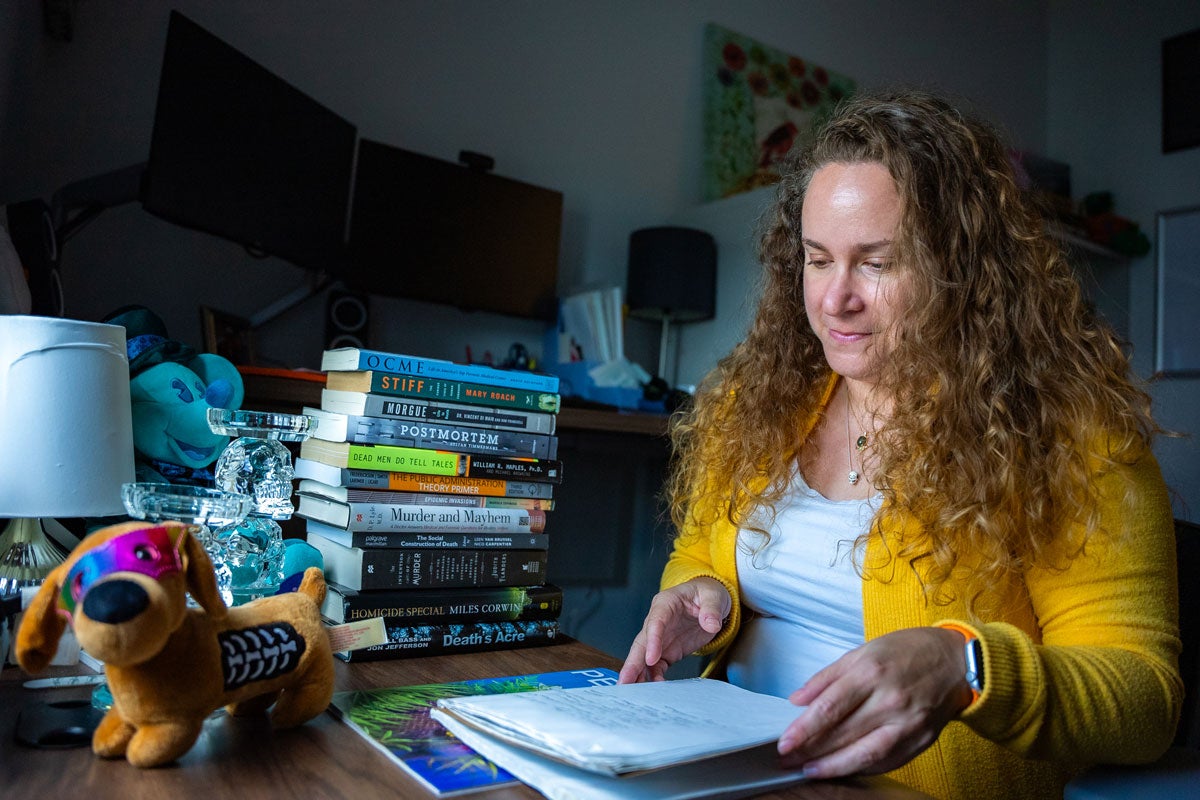Public health care and first responders are an integral part of society, but often overshadowed is the importance of “last responders” — or the professionals who deal in public death care.
Putting the spotlight on the work of these “last responders” through her research is Staci Zavattaro, a professor in the College of Community Innovation and Education’s School of Public Administration. Her passion is part of a lifelong curiosity of how society cares for the dead, and her mission is to uncover the sense of mystery those answers are often shrouded in.
As a 2022-23 Richard P. Nathan Public Policy Fellow with the State University of New York’s Rockefeller Institute, Zavattaro examined the realm of public death care via dozens of interviews with cemetery managers, medical examiners, coroners and more. Conducting this research in the wake of the COVID-19 pandemic offered Zavattaro a unique lens through which to document the exacerbated challenges death care professionals had to navigate, as well as how to inform best practices moving forward.
Understanding their backgrounds, experience and the challenges they face in their line of work can help lay the foundation for informing public policy and educating the public on the often-stigmatized role of death managers, she says.
“My goal is to spotlight those who do something that is often considered ‘dirty’ or stigmatized, and to use my research to hopefully contribute to helping overcome that stigma because I want to see these people get the recognition they so deserve,” she says.
What is public death care, and why is it important work?
My research focuses on those working for a local government entity who deal with death in some form or fashion. I’ve spoken with municipal cemetery managers, medical examiners, and coroners working in different states and at different levels of government — essentially trying to figure out how and why they do what they do. I think it’s important because, like so many other public services, we don’t really notice them until something has gone wrong. We saw examples of that during [the] COVID[-19 pandemic]. I wanted to explore this aspect of public service that doesn’t get much attention, and to dive into learning from the people who do this to understand why they have chosen to surround themselves every day with death.
What I’ve found is a lot of them are in this to make the lives of the living better through what they do. Folks who work in public death spaces come to work and see what’s going wrong, what’s going right and what we could do better. This is how we get things like seatbelt laws, improvements to airplane seats, targeted crises interventions and more. There’s this human element coupled with a science-driven, evidence-based policy aspect.
What sparked your interest in death care?
For some reason, I’ve always been fascinated by old cemeteries. It’s a running joke in my family that if there’s a cemetery nearby, I’m probably going to find it. I like walking through them and trying to imagine who folks were and what their stories are. If you look at my bookshelf from when I was a kid, my books were all about forensic anthropology, death investigation and whatnot.
But from a research perspective, I was part of a team working with the City of Orlando after [the] Pulse [nightclub shooting]. We spoke with professionals to understand what went well and where they could improve with the idea of helping other public servants who face mass-casualty events in their jurisdictions. Two of the folks the city picked for us to interview was the now-retired city of Orlando cemetery manager, and one was the county medical examiner. We listened to them speak about their roles in relation to what was then the worst mass shooting in the country, and we also looked at public management literature.
That’s where my research interest was really piqued. I just wanted to learn more about the people who deal with death and how their work improves public policy and public management. I think that’s why I’m so fascinated by the death managers: In some ways, they work in this intersection of science and emotions, and it’s really fascinating to learn about.
What are some of the challenges professionals in the field face?
The challenges are very typical of public sector entities — more time, more money, more people, more resources. Mental health and awareness for the “last responders” is also a challenge. It’s very prominent when you talk about first responders — police, firefighters, frontline workers, medical providers — but you don’t usually think about the “last responders” who do death investigations or respond in some ways to these mass-casualty events. It should be more widely acknowledged that this is a challenging job and it’s also important that the last responders get access to the mental health care they need.
The other major challenge is helping the public and lawmakers understand the role of death management in this sort of complex bureaucratic structure. It matters in the U.S. where you die and what resources you have access to because states and jurisdictions have different laws and access to resources. Getting the people who have the power to allocate more resources to better understand what these death managers do is important.
What are some of the most common misconceptions you hear about the field?
The biggest misconception I’ve heard from the medical examiners and coroners is that all they do is CSI-style crime scene work, that they solve these cases in an hour or so and it’s all wrapped up neatly, which isn’t accurate. Another big one is the link between death management in the public sector and public health. [The] COVID[-19 pandemic] was a perfect example of this: We saw healthcare systems and death care infrastructures fail.
It’s really trying to understand the connection between death care and public health apart from epidemiology along with, as mentioned earlier, how medical examiners and coroners use their data to try to improve people’s lives.
Finally, regarding cemeteries, the biggest misconception I’ve seen is that they’re just scary places. But cemeteries often are the best museums. They’re this intersection of the living and the dead. Cemeteries are meant for walking, learning, recreation, and you see living history. It’s this space that caters to many audiences but from a public management research perspective, we don’t always know a lot about them.
How can research on death care be used to inform public policy?
I hope my research can get into the hands of public managers and help them better understand their public death care entities. I heard a lot from cemetery managers, medical examiners and coroners a refrain of, “Our bosses don’t really know what we do.” It’s a big education component for them. There’s this disconnect of city managers, county managers, elected officials and so forth understanding what death managers do and the role they play within the public service.
I hope my research can get public managers thinking about this and the resources that death managers need, and that it can at least be a steppingstone for public managers to educate themselves on what death managers do and why it’s important work. I’m hopeful the same conversation can happen among our students and among the public.
What are the cultural and ethical considerations within death care?
We don’t typically think of this as a public service challenge of how public servants ensure that they’re responsive to their community’s variable needs. For example, I talked to the cemetery manager in Nome, Alaska, and she described having to learn about indigenous burials and how those customs come to fruition. Especially when it comes to death and burial, there’s a need to understand the communities in which death managers work, what cultures are involved, what the traditions are and ensuring you’re more responsive to them.
There is work to be done in bringing these challenges of equity, culture and religion, or lack thereof within death care spaces. It’s crucial to understand the communities you’re serving, what folks need, and what they want when it comes to funerals and death care. When you’re in a resource-constrained situation, it can be hard to do, but it’s not impossible.
What do you consider to be the most rewarding part of your research on public death care?
I love when I get to talk to somebody who works in a space that is often seen as stigmatized or scary and simply ask them, “Who are you? How did you get here? Why do you do this? What do you face every day?” I enjoy hearing them speak so highly of the work they do while explaining how it works in their jurisdictions. I tell them, “This is the best part of my day,” and I often mean that. It’s very rewarding to be in a profession and a position where I get to look around the world around me and ask how and why things are happening; and I get to bring those lessons to other academics, practitioners and my students. I don’t know that it gets better than that.





